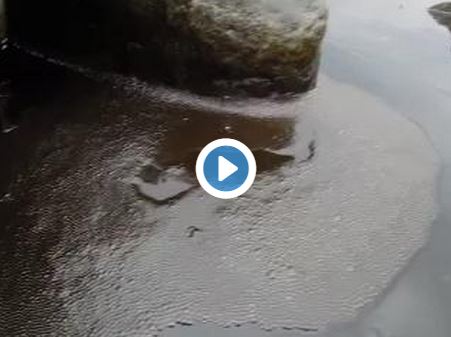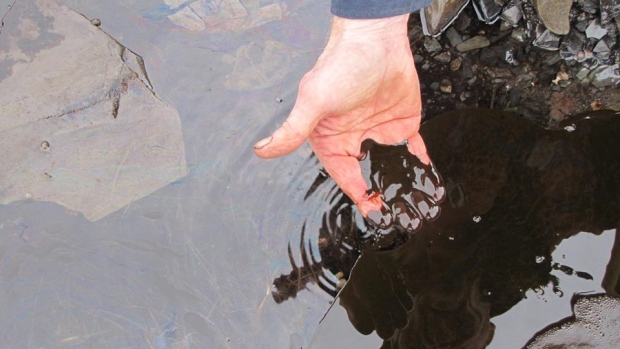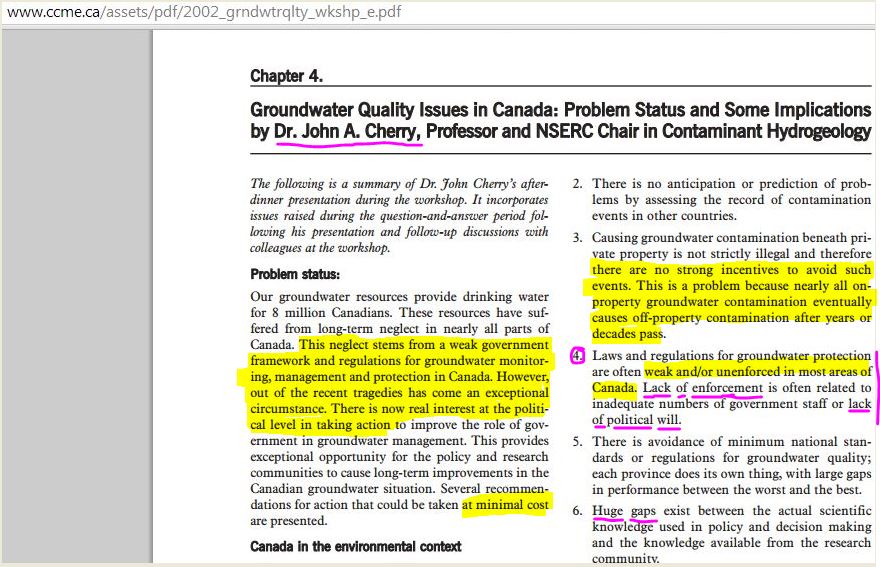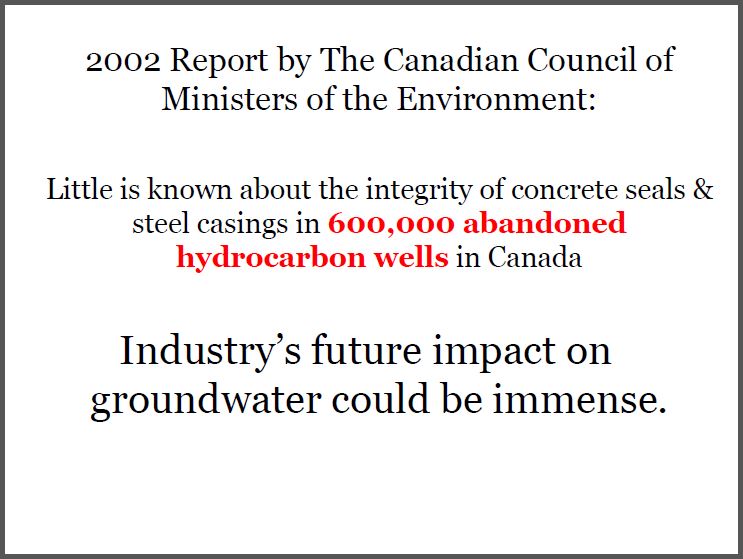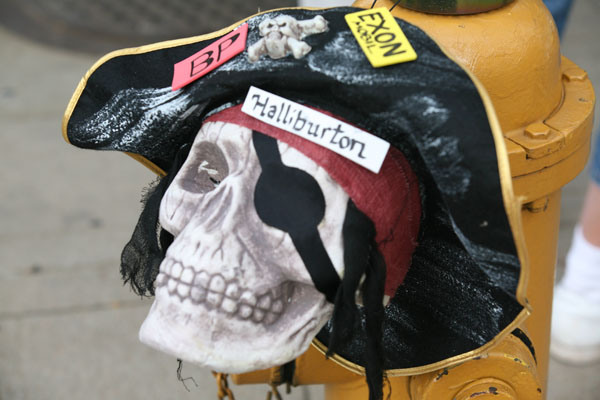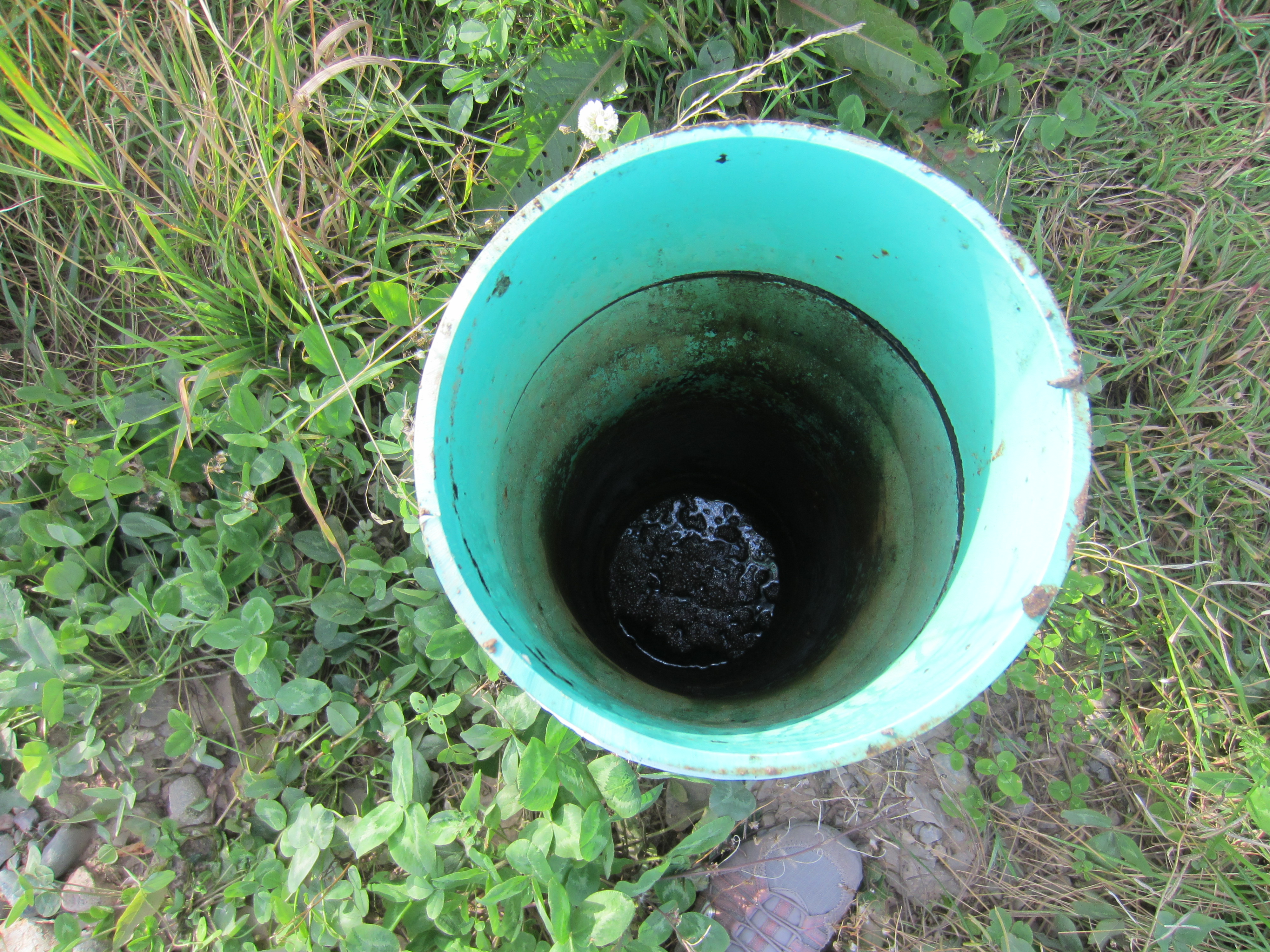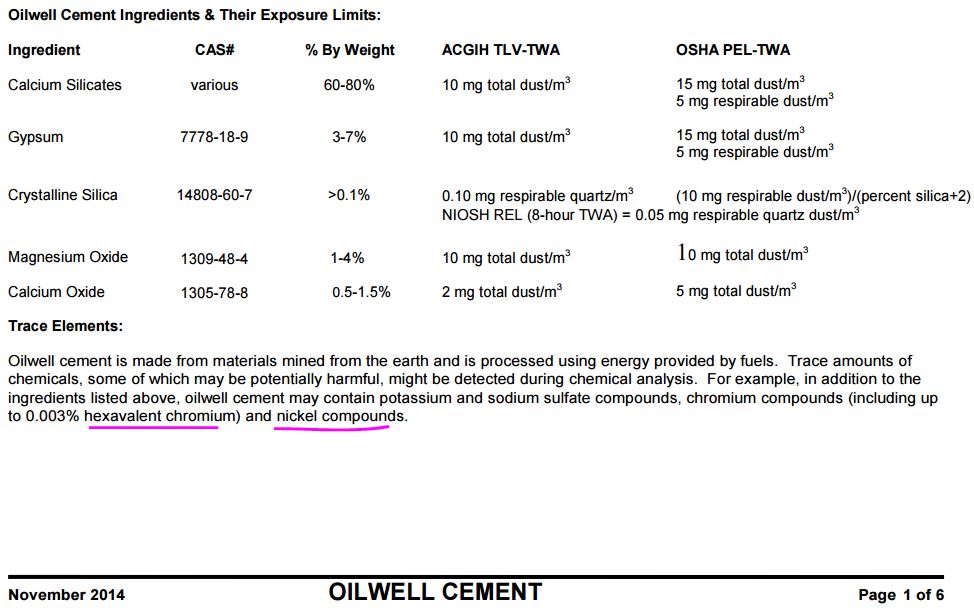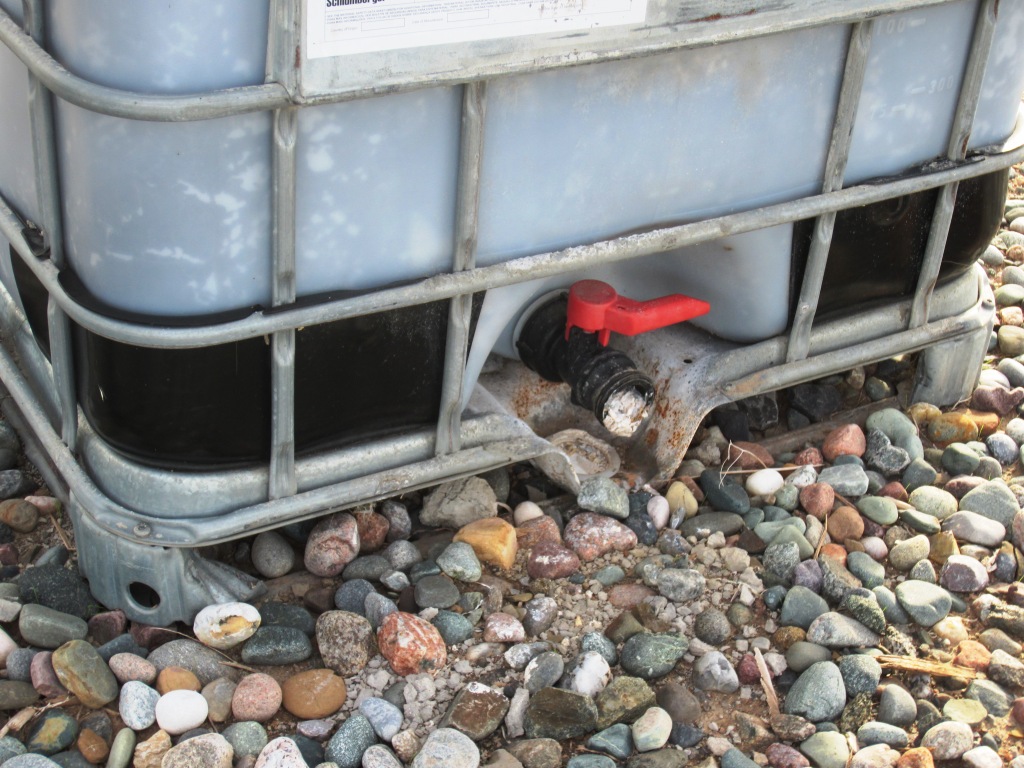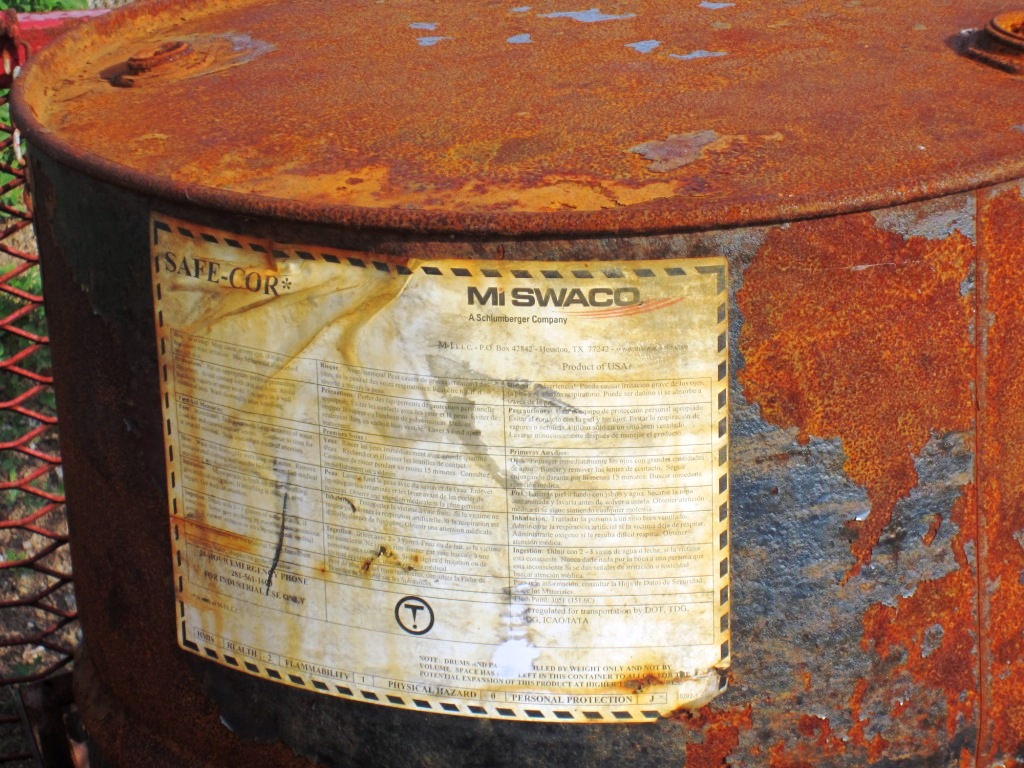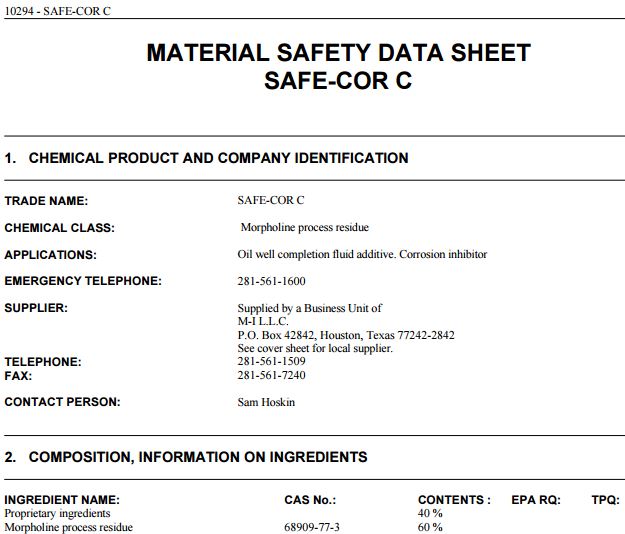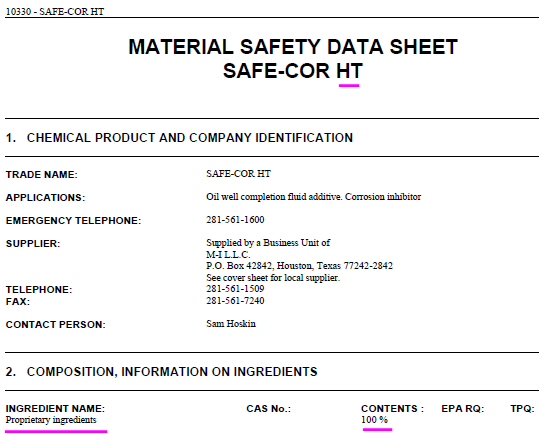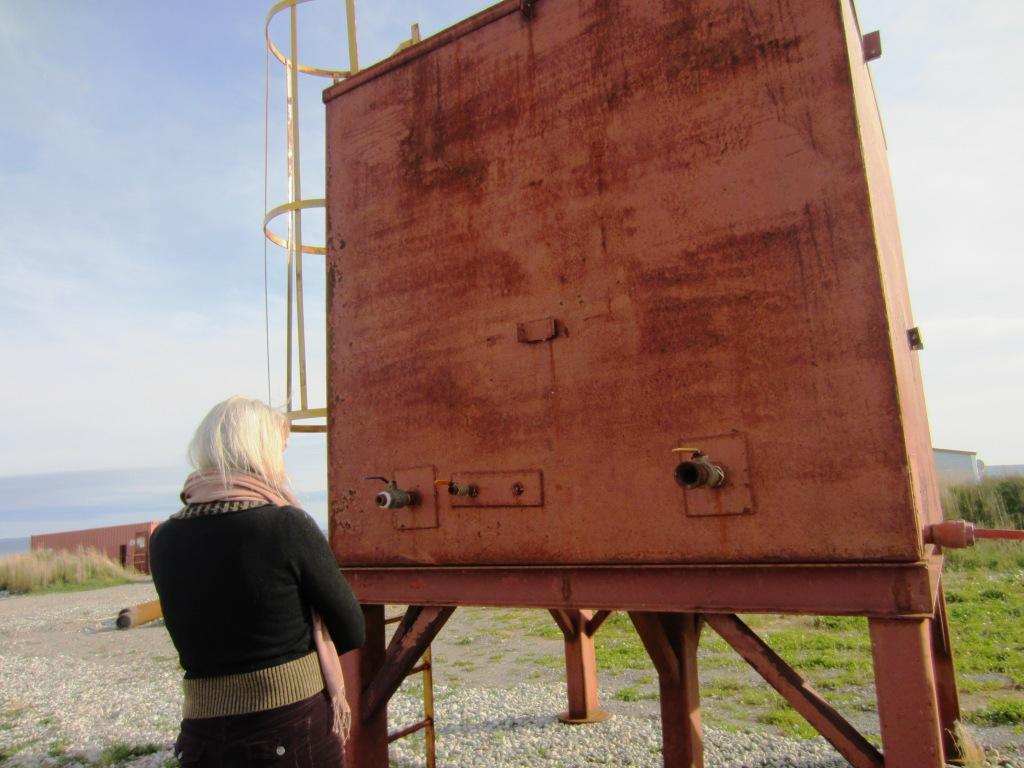EXCELLENT INTERVIEW WITH AIDEN MAHONEY: A Stephenville man says oil is seeping out from Shoal Point by West Coast Morning, June 9, 2015, CBC News
Oil seeping out into the ocean appears to come from old oil drilling sites at Shoal Point on the Port au Port Peninsula. Aiden Mahoney of Stephenville made the discovery on the weekend and posted pictures on Facebook. He spoke with Bernice.
“We saw five broken casings.”
…
“You can also see gas bubbles.”
…
“We saw oil flowing into the bay.”
Immunotoxicity and oxidative stress in the Arctic scallop Chlamys islandica: effects of acute oil exposure by Hannam ML, Bamber SD, Moody AJ, Galloway TS, Jones MB, Ecotoxicol Environ Saf. 2010 Sep;73(6):1440-8. doi: 10.1016/j.ecoenv.2010.06.012. Epub 2010 Jul 10.
Abstract
With increasing oil exploration in Arctic regions, the risk of an accidental oil spill into the environment is inevitably elevated. As a result, concerns have been raised over the potential impact of oil exposure on Arctic organisms. This study assessed the effects of an acute oil exposure (mimicking an accidental spill) on the immune function and oxidative stress status of the Arctic scallop Chlamys islandica. Scallops were exposed to the water accommodated fraction of crude oil over 21 d (maximum SigmaPAH 163 microg l(-1)) and immune endpoints and oxidative stress parameters were measured. Mortalities were recorded during the exposure and reductions in immunocompetence were observed, with significant impairment of phagocytosis and cell membrane stability. Scallops were also subjected to oxidative stress, with a significant reduction in glutathione levels and induction of lipid peroxidation. After the acute oil exposure had subsided, no recovery of immune function was observed indicating potential for prolonged sublethal effects. [Emphasis added]
Chronic toxicity and physical disturbance effects of water- and oil-based drilling fluids and some major constituents on adult sea scallops (Placopecten magellanicus) by P.J. Cranford, D.C. Gordon, K. Leeb, S.L. Armsworthy, G.-H. Tremblay, Marine Environmental Research Volume 48, Issue 3, September 1999, Pages 225–256, doi:10.1016/S0141-1136(99)00043-4
Abstract
Adult sea scallops, Placopecten magellanicus, were exposed in the laboratory under environmentally representative conditions to different types and concentrations of used operational drilling fluids and their major constituents. Threshold waste concentrations causing reductions in somatic and/or reproductive tissue growth are: greater than 10 mg l−1 for used water-based mud (WBM); 2 mg l−1 for bentonite; and less than 0.5 mg l−1 for barite and used oil-based mud (OBM). Chronic exposure to OBM caused high mortalities at concentrations as low as 1.0 mg l−1. Non-nutritious particles in the food supply (all wastes) and chemical toxicity (OBM and perhaps barite) affected the growth rate and survival of sea scallops by altering physiological state (scope for growth) and nutritional condition (O:N ratio). The value of scope for growth (SFG) calculations for assessing the relative chronic toxicity of the drilling wastes was demonstrated by the close relation observed between SFG and actual growth measurements. These results show that chronic intermittent exposure of sea scallops to dilute concentrations of operational drilling wastes, characterized by acute lethal tests as practically non-toxic, can affect growth, reproductive success and survival. [Emphasis added]
Department will deal with leaking oil: Crummell by Dorian Nijdam, June 10, 2015, TCTC Media, Special to The Star
Government scientists are investigating in Shoal Point after the Port au Port Fishery Committee released a video of oil gushing up from the sand.
Concerned residents of Port au Port area were shocked by oil flowing into bay. Check out this video. #cbcnl pic.twitter.com/tNeFavPoLL
Bernice Hillier (@BerniceCBC) June 9, 2015
Bill O’Gorman, chairman on the committee, says the oil is coming from a sheered off well, and he has been trying to get the government to deal with it for more than a year.
An investigator was sent to look at the spill last year, but determined there was no evidence of a breached well.
“The government is shirking responsibility,” said O’Gorman. “We showed them last year, but they didn’t do anything about it.”
At the time, oil was visible, but its source was unclear. It was only recently it was discovered to rising up from the sand.
Dan Crummell, the minister of Environment and Conservation, said he is concerned about the oil in water and, whatever its cause, his office will be dealing with it. The department isn’t certain if oil is coming from an abandoned drilled well or a natural spring. [The Oil and Gas industry Enabler Way: Always blame nature, especially when there’s man-made toxic pollution that will cost money to clean up, if it can even be cleaned up]
“There is lots of oil in the area; it’s not uncommon to see a little bit of it,” said Crummell. “(Access to) oil is the reason the area has been drilled since back in 1898.”
Whether the cause is natural or man-made, he said a solution will be found. [That’s what Alberta Premier Ralph Klein publicly promised (February 28, 2006) to the many families with methane and ethane contaminated drinking water wells after nearby fracing. Near a decade later, not one frac’d aquifer has been de-frac’d, none of the contaminated water supplies fixed, no solutions found.] While he isn’t sure what the protocol is for dealing with excessive natural oil, he was certain there are options.
O’Gorman is doubtful. He says that the oil in the bay is not natural.
“They’ll say anything to make small of this,” says O’Gorman. “Take it for what it’s worth, but it’s not worth much.” [Emphasis added]
‘Nothing alive’ in Port au Port Bay because of oil spill, fisherman says by CBC News, June 10, 2015
Fishermen and residents in the Port au Port region are reporting a significant amount of oil seepage in the ocean waters surrounding the area. (Submitted by Aiden Mahoney)
Reports of oil spilling into Newfoundland’s Port au Port Bay from old drilling sites is a growing concern for fishermen in the area.
Bill O’Gorman, a scallop diver and chair of the local fishery committee, says it’s been trying to get Ottawa and the province to clean up the area around Shoal Point for years after a noticeable decline in marine life in the region such as scallops, lobsters and barnacles.
“There’s nothing alive over there,” O’Gorman said. “There’s nothing sticking to the boats anymore, or the wharves. You don’t find that any more because there’s a constant spill and a slick — an oil slick that’s there every day, and every night, all the time.”
O’Gorman says oil leakage is nothing new for the area, as drilling operations have been taking place there since the late 1800s.
“There’s been oil leakage there for the last 50-60 years,” he told CBC News.
“Fisherman have been using that oil to stain their sheds and to oil their rollers and to paint their fence posts.”
He blames the spill for the collapse of the region’s scallop fishery, and has been trying to get some level of government to do something about it.
“We would like to see some department, provincial or federal, remedy this situation,” he said.
“This is going to cause a complete collapse of the fishery in Port au Port Bay.”
O’Gorman said he has video that proves the oil slick has intensified as of late, and said at this point you can clearly dip your hand in the water and pick up crude oil as a result.
He said, if it comes to it, the committee will start looking at ways to get attention such as protests and marches.
As well, he worries about how future drilling activity will compound the problem if something isn’t done to clean up the damage that is already done.
“It’s about time that something was done about it,” he said.
“If they can’t control traditional drilling that happened 50 and 75 years ago, what are they going to do with this new technology, fracking?” [Emphasis added]
Leaking oil at Shoal Point emphasizes potential fracking hazard by NDP Environment and Conservation Critic George Murphy, June 8, 2015
NDP Environment critic George Murphy (MHA, St. John’s East) says horrific pictures of leaking oil from abandoned drill heads on Newfoundland’s west coast highlight one of the major environmental hazards the province could face if hydraulic fracturing (fracking) is ever permitted here.
Murphy says the well heads date from wells drilled possibly in the 1960s or the 1890s; the fact that they already pose as much of a hazard as they do is proof enough for him that there is no way to guarantee the long-term safety of the environment once drilling is permitted.
“Whether these leaks are coming from wells drilled 50 years ago or 120 years ago, it’s a short amount of time in a province’s history,” Murphy said.
Photos shared on the Port au Port/Bay St. George Fracking Awareness Group Facebook page show oil running into Port au Port Bay; in one, a person’s hand is covered in oil. Some of these wells were originally drilled on [shore], but because of regular coastal erosion are now in the bay.
Nobody seems to be taking responsibility for [the] cleanup, the MHA added. “The drilling predates the CNLOPB, so they have nothing to do with it, the provincial environment department has been mum, and we haven’t heard from the feds either,” he said.
“It’s obvious that we have a serious environmental concern on our hands and ignoring it is not going to make it go away.”
The pictures can be seen here:
https://www.facebook.com/groups/471261759605852/permalink/878934888838535
Oil slick on Port au Port Peninsula raising alarms by CBC News, June 09, 2015
Reports of oil flowing into the bay on the Port au Port Peninsula is causing concern among local residents and in the House of Assembly. Aiden Mahoney, who lives in Stephenville, saw oil seepage and broken pipe casings when he and a friend hiked out along the shoreline last week.
“When we were about a quarter of a kilometre from the site, we could smell a rank smell. We didn’t know what it was,” said Mahoney.
“We thought it was just going to be oil seeps, but now it’s actually oil flowing into the bay.”
Mahoney said residents have always known about the oil slick, but did not know how bad the situation had become.
“We were shocked.”
Mahoney said the casings were falling apart in his hands, and that oil was bubbling up to the surface.
Mahoney posted pictures of the oil on Facebook, which caught the attention of several provincial politicians.
Environment Minister Dan Crummell said he first heard about the slick through social media.
“We are on top of this. We’re looking into it,” Crummell told the House of Assembly.
“We need to determine how this is happening, whether it’s a natural occurrence or if it’s coming from former oil drill sites.”
Crummell said an official was sent to the site last week, and the government is presently collecting more information. He said his department needs to know the extent of the situation before deciding on the next steps.
But Mahoney said politicians have known about the oil slick for years. He said he has alerted federal and provincial government to the situation many times, but has always been passed off.
“I guess they acted on this yesterday because they were embarrassed because of Facebook,” said Mahoney.
“We want to see it cleaned up right now.” [Emphasis added]
…
DID INDUSTRY’S CRUMBLING OIL WELLS , LEAKING OIL AND OTHER CHEMICALS, KILL THE SCALLOPS AND ROCK CRAB IN THE BAY?
Testing to determine why scallops are dying in Port au Port Bay by Frank Gale, November 28, 2013, The Western Star
While sample testing may provide some clues as to why there is a sharp decline in scallops in Port au Port Bay, a steering committee has been formed to keep an eye on the situation.
During a fishery meeting held Wednesday night at West Bay Community Centre, much concern was expressed about the rapid decline of scallop and rock crab stocks in the bay. About 40 people were in attendance.
Fish harvesters are especially interested in finding out what is causing the scallops to die and whether anything can be done to help them rebound.
Gus Hynes, a fish harvester out of Port au Port Bay, said he had done some sampling that very afternoon and the numbers from three tows gathered 188 scallops. Of those, only 16 were live scallops and the other 172 were dead, or what’s known as “clappers.”
During an open session at the beginning of the meeting, Roger Duffy said he was told some years back that there was a bacterial infection in these animals from wastewater being dumped into the bay. But Duffy doesn’t buy that theory, saying there is less population now and less hazardous chemicals today from soaps and detergents used in homes.
Bill O’Gorman, a diver who harvests scallops, said he has heard that fecal matter doesn’t affect scallops.
Duffy also pointed to what he believes is a problem with the location of the drill well at Shoal Point because it’s at the very tip of the point — a flood area in certain storms.
September 13, 2012: File photo, The Western Star, The Shoal Point drilling site. REFER ALSO BELOW TO 2013 PHOTOS OF THE MESS LEFT BEHIND
There is fear that wastewater from drilling operations that took place on the point may be getting into the bay. Concern was also expressed that abandoned oil wells in the bay that were once on land could possibly be leaking.
Ken (Mutchie) Bennett said he once dived for scallops in Port au Port Bay and grew up living from the land and the water.
“Now it seems we have to put a big fight on for the protection of our environment,” he said.
Jerome Hoskins of Boswarlos said with the decline of scallops and rock crab, he fears that lobster could be next.
“Whatever is causing this, it could happen to them too as they’re bottom feeders,” he said. [What about humans and their children eating products from the bay?]
Jason Spingle of the Fish Food and Allied Workers Union said he would like to see sediment and water samples taken. He said Port au Port Bay is of special concern because it’s a shallow bay that doesn’t have great flushing potential.
“There are areas that are more sensitive than others because of what’s going on in and around the bay, so some credible water sampling should be done,” he said.
[REALITY CHECK: Expect water sampling in Canada under master enablers Steve Harper and hydrogeologist Dr. John Cherry? Dr. Cherry has been promoting water sampling and monitoring since 2002, getting nowhere but appointed a decade later as Chair of Canada’s “expert” Council of Canadian Academies (CCA) frac panel and presenting frac propaganda at the Munk School of Global Affairs U of Toronto 2014 keynote:
Slide in Dr. Cherry’s 2014 keynote: Hydraulic Fracturing, An Amazing North American Technology.
Why did Dr. Cherry and his CCA frac panel, leave out the publicly available data proving that Encana fractured directly into Rosebud’s drinking water aquifers? Even the US EPA included it in their 2015 frac report! Why such a damning omission by Dr Cherry and his CCA frac panel?
And worse, why did Dr. Cherry omit his vital Chapter 4 on Canadian groundwater contamination problems and the inability of regulators to remedy them, published in 2002 by the Council of Ministers of the Environment (CCME)?
Slides from Ernst presentations
COVER UP & SECRETS TOP UP CANADA’S “EXPERT” WATER POLLUTION ENABLING?
In late 2014 or early 2015, the CCME removed from their website their 2002 publication edited by Allen Crowe et al that summarized dire warnings about unconventional oil and gas impacts to water, and accompanying groundwater pollution concerns by Dr. John Cherry. The report had been publicly available on the CCME site for years. Ernst filed it in document exchange with Encana on October 31, 2014.
Why remove the evidence 13 years later?

In 2015, Ernst vs Encana uploaded the report to keep it available to the public
END REALITY CHECK]
John Lubar, area director with the federal Department of Fisheries and Oceans, said he’s heard there are several issues to blame, and it all adds up to polluted waters, whether it’s from wastewater or petroleum.
He promised that samples Hynes brought would be sent off to the DFO animal health laboratory in Moncton, New Brunswick for testing to see if the cause for these dying scallops can be determined. [Cleverly avoiding what needs to be sampled: the water!]
At the end of the meeting, a steering committee was struck consisting of Spingle, representing the FFAW, along with a number of local area fish harvesters. [Emphasis added]
Pollutants blamed for Port au Port Bay scallop fishery collapse by Frank Gale, February 07, 2014, The Western Star
Local fish harvesters believe that environmental pollutants, possibly from oil and industrial developments in the area, may be contributing to the drastic decline in scallops in Port au Port Bay.
The Port au Port Bay Fishery Committee intends to act on its concerns about the collapse of the scallop fishery and threats to the local marine ecosystem. The committee, which met earlier this week in Port au Port East, has created subcommittees and an action plan to deal with its concerns.
Scallop fisher harvesters in the Port au Port Bay region reported never before experiencing such a widespread collapse of the scallop fishery in the bay. Now, laboratory test results on scallops submitted to the federal Department of Fisheries last November came back inconclusive in relation to the cause of the collapse.
The group said in a prepared release that it’s disappointed the scallops were not tested for petroleum contaminants. Fish harvesters also report sea urchins have gone and there is a decline in rock crab.
Committee member Gus Hynes said in the release that he and his crew are quite concerned that developments have been occurring around Port au Port Bay without due regard to the impact on scallops and other marine species.
He believes past government environmental assessments done under the jurisdiction of the Canada Newfoundland Offshore Petroleum Board are not adequately protecting fishery interests and the marine environment.
The 2007 Environmental Assessment for the Port au Port Bay Exploration Drilling Program at Shoal Point makes no mention of the potential high risk and vulnerability of the site to tidal surges, coastal erosion and other impacts from extreme weather related to climate change.
Bill O’Gorman, scallop diver and fishery committee spokesperson, said the name of the area “Shoal” Point should have warranted at least some reference in the 2007 Environmental Assessment to the risk involved with drilling at such a vulnerable site.
“The alarming fact is that drilling was approved on an exposed shoal at the tip of a point jutting out some eight kilometres towards the centre of Port au Port Bay,” he said.
O’Gorman believes the environmental and health risks of oil drilling on a shoal are more serious today due to increasing extreme weather, rising ocean levels and tidal surges. [Emphasis added]
Shoal Point CEO expecting lots of progress by Cory Hurley, September 13, 2012, The Western Star
Shoal Point Energy Ltd. is hoping to have at least three wells drilled and stimulated in western Newfoundland by next summer.
George Langdon, the company’s chief executive officer, also said the company with rights to much of all the land in the Green Point area is actively seeking a major investing partner to advance its projects in the near future.
In 2011, exploratory drilling in the Port au Port Bay area did not go as planned for the company. Operational problems prevented the testing from getting the natural flow from the reservoir that was expected, he explained.
Other tests though helped the company gain valuable engineering data, and they remain confident in the potential of the play, said Langdon. They are expecting to return to drill a third side track at the site by next year, and pending environmental approvals will do hydraulic fracturing to stimulate the reservoir.
Further north, the company is hoping to drill exploration wells near Little Port and along the lower Northern Peninsula — two sections of the large regional shale play — later this year or in 2013. When the rigs are transported onto the island, by the end of next summer, each of those wells could be stimulated to see if the hydraulically fractured Green Point shale will flow. [Why spend millions of dollars to frac to try to force oil to flow, if nature does it for free, at the snap of a press conference, as soon as contamination shows up?]
“At that point, we would establish the viability of the play over a very large area, and enable us to move forward with our plan to maintain those licences, drill more wells [and leave toxic mess behind at every site and frac beneath each bay?], and eventually getting into production on those licences going forward,” Langdon said.
The CEO said the relationship with the regulatory body — Canada-Newfoundland and Labrador Offshore Petroleum Board — has been a positive one. In general, he said the recognition of the interest and need to mine regional shale play has changed the face of the industry in North America.
Source: FrackingColorado
The key piece now is finding ways to stimulate [aka frac], extract, and ultimately produce that fuel. A key component is financing [aka subsidies via taxpayers], said Langdon. In the last six years or more, he said the company has spent close to $50 million in the area — most of that raised by the publicly traded company.
Getting to the point where they have demonstrated the viability of the oil in these western Newfoundland locations — as much as 23.5 billion barrels in one estimate — they are actively searching for a joint venture partner to invest.
“We feel very confident that we can identify the partner we need, and enter a commercial relationship to get the operations moving forward over the next 12 months or so,” Langdon said. “My dream would be, by the end of next summer, to have at least three wells drilled and stimulated [aka fracked].”
Attracts investment
There are other industry players interested and active in developments throughout western Newfoundland. The CEO said this is positive for the industry — that any company which attracts investment and activity in the area would benefit all.
“Everybody seems to agree there is a lot of evidence for oil up and down the coast,” he said. … Langdon said his company is aware of, and pays particularly close attention to, the strict regulations which the industry must adhere to. [Refer to the after drilling photos below for an excellent example of “must adhere to”] He also said they are conscious of the potental environmental impacts and dangers of their work. He said the history of oil and gas development around Newfoundland has been a good one — noting the lengthy past of exploration/development in the Grand Bank without any major incidents.
“We are only interested in preserving the environment,” [Again, refer to after drilling photos below] he said. “Obviously, we are interested in development as well.”
Langdon said it is up to the people of western Newfoundland to pass along their opinions — to their elected officials through processes such as environmental assessments — on whether or not they want development. “I believe this can be carried out in a very safe and economically sound manner,” he said.
Langdon will be one of today’s speakers at the 2012 Western Newfoundland Oil and Gas Symposium in Corner Brook. It continues Friday. [Emphasis added]
…
WHO WILL ASSESS AND MITIGATE THE CUMULATIVE IMPACTS IF FRACING PROCEEDS IN PORT AU PORT?
2013 September 21 photos of Shoal Point, after drilling: One example of the oil and gas industry mess left behind and ignored by federal and provincial regulators (aka pollution and harm enablers) and company alike:
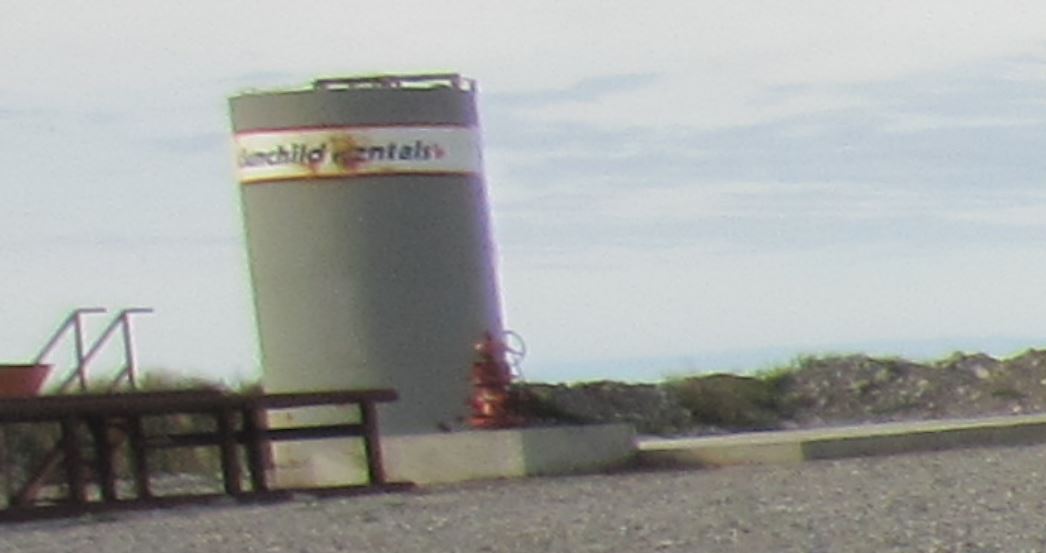
Monitoring oil in the water? Where’s the data?

Example of Class G Cement: API Oilwell Cement, Class ‘G’, Moderate Sulphate Resistant
CAS #: 65997-15-1. Snap taken June 11, 2015
Why is the physical hazard “6” and what is meant by personal protection “3” (Refer to bottom of the label).
How long will this container remain intact?
Which Safe-Cor product is it?
Do the enablers know?
Complete MSDS for Safe-Cor C. Snap taken June 11, 2015
Complete MSDS for Safe-Cor HT. Snap taken June 11, 2015
 Complete MSDS for Safe-Cor E. Snap taken June 11, 2015
Complete MSDS for Safe-Cor E. Snap taken June 11, 2015
Photos above of the mess left at Shoal Point taken September 21, 2013.
Photo below of Ernst presenting in Stephenville the next day, last slide shows location of the drilling location at Shoal Point (circled in pink).

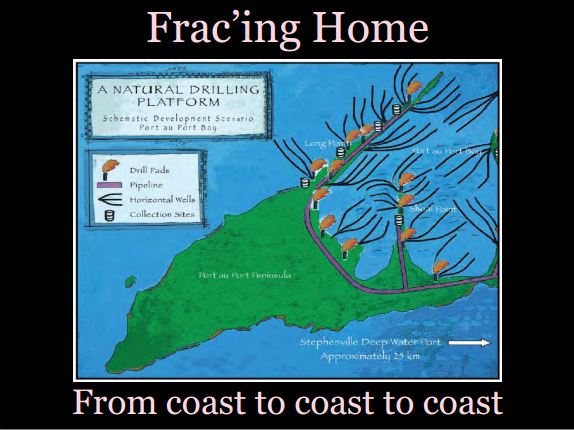
Art work above (in last slide of Ernst presentation September 22, 2013, Stephenville, NL) by Reed Weir, 2013

